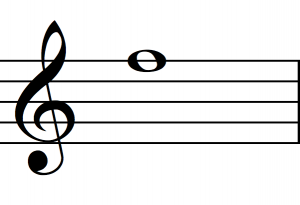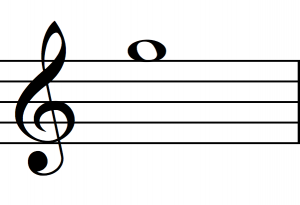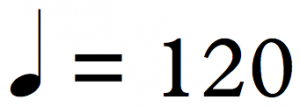3 Notes on the First String & Tempo
INTRODUCTION
In this unit you will learn two fretted notes on the first string and a variety of tempo indicators.
Notations
Notes
The Note ‘F’

‘F’ is on the top line of the staff. To play ‘F’, fret the first fret on the first string.
The Note ‘G’

‘G’ sits directly on top of the staff. To play ‘G’, fret the third fret on the first string.
Tempo
Tempo is the speed, or pace, of a piece. It can be conveyed in two ways: in beats per minute (BPM) or with descriptive words.
Beats Per Minute (BPM)

BPM is the most precise way to convey tempo. A rhythmic value is equated to a number that represents beats per minute. In the example, a quarter note equals 120 beats per minute, which means that the pace will unfold as two beats per second. To find an exact BPM, you can purchase a metronome or visit this free site: https://www.metronomeonline.com/.
Descriptive Words
Prior to the invention of the metronome, composers used descriptive words to indicate tempo. Many composers continue to employ these words along with or instead of metronome markings. Below is a list of ten commonly used tempo indicators. Italian words are traditionally used. You will probably encounter other words (in Italian, French, German and other languages) that are not listed here. Most of the time, the definition can be found with an online search.
| Tempo | How to Play | Approx. BPM |
| Largo | broadly | 40-60 |
| Lento | slowly | 45-60 |
| Larghetto | a little faster than Largo | 60-66 |
| Adagio | moderately slow | 66-76 |
| Andante | walking pace | 76-108 |
| Moderato | moderately | 108-120 |
| Allegro | happy, or fast | 120-168 |
| Vivace |
lively and fast | 168-176 |
| Presto | very fast | 168-200 |
| Prestissimo | faster than Presto | higher than 200 |
Let’s Play |
Sight-Reading Tip
If you drop the rhythm—meaning you lose your place while sight-reading—I suggest you play only the first beat of each measure. This will allow you to mentally keep your place in the rhythmic scheme. When that becomes manageable, play only the first and third beats of examples in 4/4 time. Finally, when that becomes manageable, play the entire exercise.
Theodore Norman advocated this method and many guitarists have used it to become great sight-readers. However, this is but one creative solution to a sight-reading obstacle. All great sight-reading guitarists engage in creative problem solving. Think of an obstacle as an opportunity to invent a creative solution. Then, create a solution and put it into action.
Checklist for Sight-Reading
- Count the beats out loud (including the &).
- Keep going (even if you make a mistake).
- Maintain your best playing posture.
- Look at the score, not your hands.
- Play with the feel of the meter.
- Play patterns instead of individual notes (AKA chunk).
- Have fun!
Let’s Play Rhythms |
Attitude Tip
To practice is not to collect things and put them in your basket, rather [it is] to find what is up your sleeve. –Shunryu Suzuki
Exercise 3.1: Score
Exercise 3.1: Audio
Exercise 3.2: Score
Exercise 3.2 Audio
Exercise 3.3: Score
Exercise 3.3: Audio
Exercise 3.4: Score
Exercise 3.4 Audio
Exercise 3.5: Score
Exercise 3.5: Audio
Exercise 3.6: Score
Exercise 3.6 Audio
Let’s Play Patterns |
Attitude Tip
We cannot solve our problems with the same level of thinking that created them. –Albert Einstein
Exercise 3.7: Score
Exercise 3.7: Audio
Let’s Play Duets |
Attitude Tip
Everything is perfect, but there is a lot of room for improvement. –Shunryu Suzuki
Exercise 3.8: Score
Exercise 3.8: Audio
Exercise 3.9: Score
Exercise 3.9: Audio
Exercise 3.10: Score
Exercise 3.10: Audio
Congratulations!
You have completed this unit! If you kept up with the beat and accurately played approximately 70% of the pitches and rhythms, you are ready for the next unit. Feel free to repeat the exercises. However, do not play them so often that you memorize them. Once you memorize the notation, you are no longer developing the skill of sight-reading.

